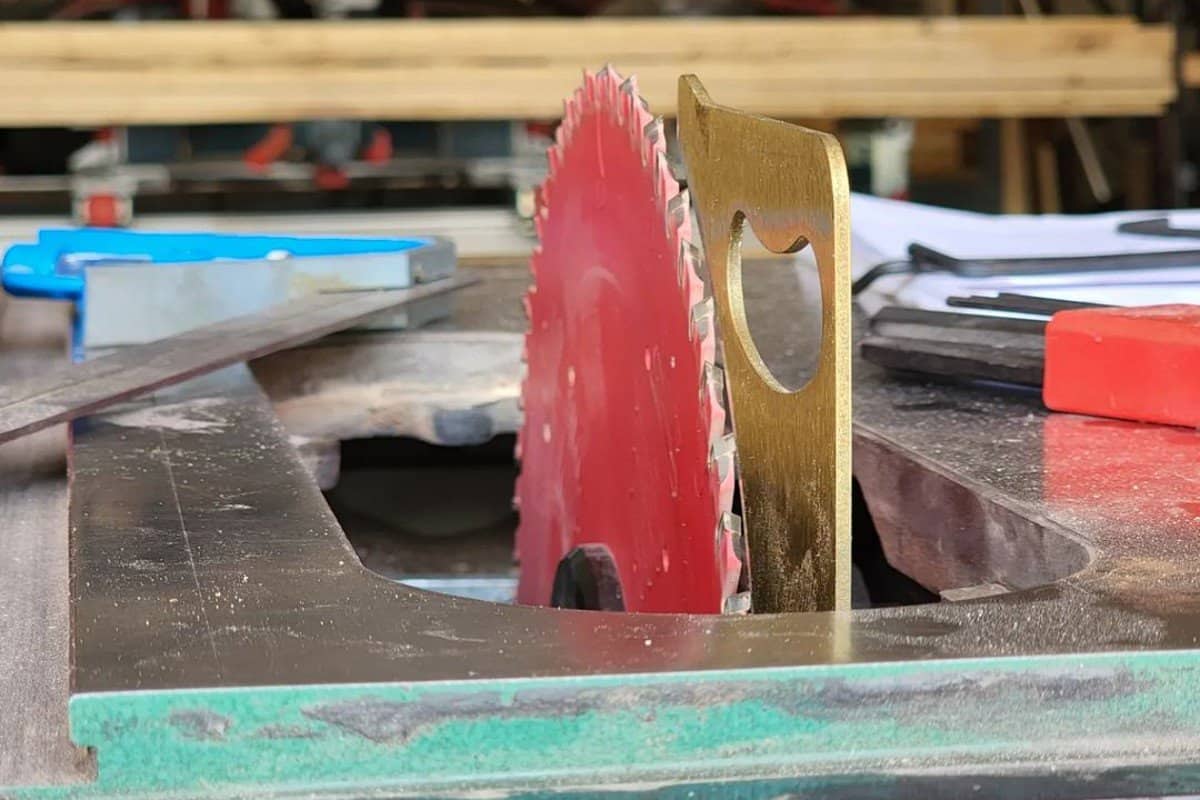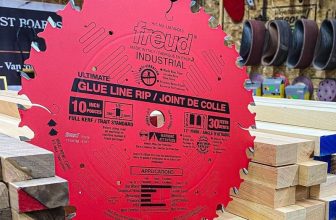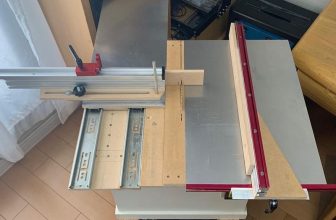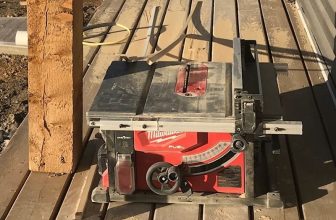What Is Riving Knife For Table Saw – Full Guide
A riving knife is a critical component of a hybrid table saw that helps to prevent kickback. When the blade of the saw cuts into the material being cut, the riving knife helps to keep the material from being forced back towards the operator.
Many injuries occur as a result of kickback, so having a riving knife in place is essential for safety. The knife is typically a thin piece of metal that is mounted to the saw blade guard and helps to keep the material from being forced back towards the operator.
There are a few different types of riving knives available, and each has its own benefits and drawbacks. It is important to choose the right type of knife for your table saw to ensure optimal safety. In this article, we will take a closer look at the different types of riving knives and help you choose the right one for your needs.
Contents
- 1 What Is a Riving Knife On a Table Saw?
- 2 What Does a Riving Knife Do?
- 3 How Thick Should a Riving Knife For Table Saw Be?
- 4 How Does a Riving Knife Prevent Kickback?
- 5 Should the Riving Knife Be Higher Than the Blade?
- 6 What Is The Difference Between a Riving Knife and a Splitter?
- 7 What’s The Difference Between a Riving Knife and an Ordinary Table Saw Blade Guard?
- 8 FAQ
- 9 Conclusion
What Is a Riving Knife On a Table Saw?
A riving knife is a thin piece of metal that is mounted to the saw blade guard. It helps to keep the material from being forced back towards the operator when the blade of the saw cuts into the material.
There are a few different types of riving knives available, and each has its own benefits and drawbacks. It is important to choose the right type of knife for your table saw to ensure optimal safety.
What Does a Riving Knife Do?
If it has a riving knife table saw is less prone to kickbacks. Kickback is a dangerous event that can occur when the wood being cut gets stuck on the blade and is propelled back towards the operator. The riving knife is a horizontal metal blade that is positioned just in front of the saw blade. It helps to keep the wood from getting stuck on the saw blade and kicking back.
The riving knife is attached to the saw blade guard. As the saw blade moves up and down, the riving knife moves with it. It is important to make sure that the riving knife is adjusted to the same height as the saw blade. This can be done by using the riving knife adjustment knob on the saw.
How Thick Should a Riving Knife For Table Saw Be?
There is no definitive answer to the question of how thick a riving knife for table saw should be. The thickness of the riving knife should be based on the width of the blade and the thickness of the kerf. A riving knife that is too thin may not be effective in preventing kickback, while a riving knife that is too thick may be difficult to install and may increase the risk of blade contact with the riving knife.
How Does a Riving Knife Prevent Kickback?
When you are using a table saw, the blade can kickback towards you. If the blade catches the material and pulls it back towards the saw, the saw can kickback towards you. This can cause serious injury.
A table saw riving knife is a thin metal blade that is attached to the saw table. It helps to keep the material from being pulled back towards the blade. This can help to prevent kickback.
Should the Riving Knife Be Higher Than the Blade?
There is some debate over how high the riving knife should be in relation to the blade on a table saw. Some say that the knife should be higher, while others say that the knife should be lower. So, which is correct?
The answer to this question depends on the type of cut you are making. If you are making a crosscut, the knife should be lower than the blade. This is because the knife helps to keep the stock from binding against the blade, which can cause kickback.
However, if you are making a rip cut, the knife should be higher than the blade. This is because the knife helps to keep the stock from binding against the fence, which can cause the stock to kick back.
What Is The Difference Between a Riving Knife and a Splitter?
When you’re looking to buy a new saw, you might be wondering what the difference is between a riving knife and a splitter. Both of these tools are designed to help keep you safe while you’re sawing, but they do different things.
A riving knife is a thin, metal knife that is attached to the saw blade. It helps to keep the kerf open so that the blade doesn’t pinch the wood and kick back towards the operator. A splitter is a piece of wood or metal that is attached to the saw blade and helps to keep the kerf open.
A riving knife is more effective than a splitter because it is attached to the blade. This means that it is always in the same position and it can’t be knocked out of the way. A splitter can be knocked out of the way if something gets stuck in the blade or if the wood binds.
What’s The Difference Between a Riving Knife and an Ordinary Table Saw Blade Guard?
A table saw blade guard is an important safety feature of a table saw. It covers the blade when the saw is not in use, and it is important to have the blade guard in place when the saw is in use. A riving knife is a thin metal blade that is attached to the saw table and helps to keep the workpiece from binding against the blade during a cut. The riving knife is also important for safety, because it helps to keep the workpiece from being thrown out of the saw.
There is a big difference between a table saw blade guard and a riving knife. A table saw blade guard is a safety feature that is important to have in place when the saw is in use. A riving knife is a thin metal blade that is attached to the saw table and helps to keep the workpiece from binding against the blade during a cut. The riving knife is also important for safety, because it helps to keep the workpiece from being thrown out of the saw.
If you are looking for table saws with riving knives, then you should look for a table saw that is equipped with a riving knife system. This system includes a riving knife, a splitter, and a pawl. The riving knife is a thin metal blade that is attached to the saw table and helps to keep the workpiece from binding against the blade during a cut. The splitter is a thin metal blade that is attached to the saw table and helps to keep the workpiece from binding against the blade during a cut. The pawl is a small metal arm that is attached to the saw table and helps to keep the workpiece from binding against the blade during a cut.
A table saw with a riving knife system is a safer saw than a table saw with a blade guard. The riving knife helps to keep the workpiece from being thrown out of the saw, and it also helps to keep the workpiece from binding against the blade during a cut. The blade guard does not do this as well as the riving knife, so a table saw with a riving knife system is a safer option.
FAQ
Why buy a table saw with a riving knife?
A riving knife is a key safety feature on a table saw. It helps to keep the material from binding against the blade and causing a kickback.
How to add a riving knife to a table saw?
There are a few different ways to add a riving knife to a table saw. You can buy a table saw that already has a riving knife, or you can add a riving knife to a table saw that doesn’t have one.
To add a riving knife to a table saw that doesn’t have one, you’ll need to purchase a riving knife kit. The kit will come with instructions on how to install the riving knife.
Do I need a riving knife on my table saw?
A riving knife is not required on a table saw, but it is highly recommended. The riving knife helps to keep the material from binding against the blade and causing a kickback.
Conclusion
A riving knife is a key safety feature for table saws. It is a thin metal blade that is mounted on the saw blade arbor and projects above the table surface. It helps to keep the workpiece from slipping between the blade and the rip fence, and it also helps to keep the workpiece from binding against the rip fence and the blade.
Also Read:
References
- Riving knife
https://en.wikipedia.org/wiki/Riving_knife - SAW BLADE KERF
https://www.yorksaw.com/saw-blade-kerf/ - Table Saw Blade Guard: Do You Really Need It?
https://abutterflyhouse.com/table-saw-blade-guard-need-it/
“A good tool stays with you for many years and choosing carefully ensures the job is done right, your work is neat, and the tool is always a pleasure to use”







